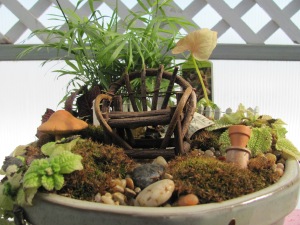
Sunshine Plant Company opens its doors to houseplant lovers
Published in the Wyoming Tribune Eagle Dec. 2, 2022.
By Barb Gorges
Just in time for the height of houseplant season, the Sunshine Plant Company opened its doors Oct. 13 at 600 W. 17th Street, on Cheyenne’s West Edge.
Yes, I know, many houseplants live year-round indoors. But once outdoor gardening season is finished, it’s time to focus on houseplants.
The Sunshine Plant Company is a boutique specializing in houseplants: succulents, cacti, orchids, violets, bromeliads and other mostly tropical plants large and small. Customers can make requests.
The shop creates dish gardens and fairy gardens, terrariums, and self-watering planters. They will replant your plants for you. Commercial and residential plant maintenance is also part of the business plan.

With garage door-sized, south facing windows (it was an automotive shop once), this is the living room you wish you had. Co-owners Cylie and Alexa Blooding-Erickson describe the vibe as “modern Victorian.” No minimalism here, but a deep gold and green living room with comfy wing chairs. It gives you a better sense of a plant’s size to see them on a bookshelf or flourishing by the vintage dresser.
And if you like the hanging shelves, you can order a set for yourself. Alexa’s brother will make it for you.
Cylie and Alexa met at the University of Wyoming’s art department and after graduation (Cylie, international studies, and Alexa, sculpture with a minor in anthropology), they went off to see the wider world.
For Cylie, that included two years at Palmer Flowers in Fort Collins, Colorado, working in their extensive houseplant production greenhouse. For Alexa, inspired by gardening with her grandmother, it included accumulating one houseplant at a time, thoroughly researching it and learning to grow it before moving on to the next type.
Both had dreams of entrepreneurship someday, and when Alexa’s mom, Christina Blooding, offered to share half the 17th Street location of her business, Flydragon Design Art Studio, a “paint and sip” enterprise, they jumped at the chance to come home. Cylie is a native of Pinedale and Alexa graduated from Cheyenne Central High School.
For now, their plants come from Denver-area vendors. The Colorado Front Range has a long history in horticulture. But in the future, Cylie hopes to propagate more plants.
With more than a nod to sustainability, all kinds of containers have been converted to pots. The vintage teacups in the cup and saucer sets have drainage holes drilled so they are safe for plants.
The most intriguing repurposing is based on a design found on the internet. It cuts a wine bottle off at the shoulders, inverts the neck, plants it with tiny plants and a wick that trails out the mouth of the bottle. The lower part of the bottle is partly filled with water with the inverted part placed on top. The wick keeps the plants in moist soil. There were already a lot of wine bottles on site from Flydragon’s paint and sip sessions.

Coming up Dec. 17 is a Plant and Paint workshop – plant succulents and paint a desert scene to make them feel at home.
Dec. 22 there will be a plant swap. Everyone from the “Oops I Wet My Plants” Facebook group, with 2,300 mostly Cheyenne members, is looking forward to that. I met one of the members, Christine Rowen, at the shop. She has helped get the word out by designing the flyer. Like many of us, she couldn’t leave without taking home a new, intriguing plant – or two.
Alexa and Cylie encourage houseplant owners to bring in their plant problems – but either as photos or specimens safely sealed in plastic zip-locking bags to protect the plants in the shop.
Like other people answering the public’s plant questions, Cylie and Alexa find the most common problem is overwatering. Here’s the tip for most houseplants: don’t water again until the top half to one inch of soil feels dry.
When watering, never pour in more water than the saucer under the pot can hold. Wait a minute to see if there is water trickling into the saucer. If there isn’t, water a little more. When there is water in the saucer finally, dump it out and quit watering. Or just water your plants in the kitchen sink.
Alexa recommends pothos, spider plant and peace lily for beginners as they are the most forgiving. She also thinks of them as drama queens because when they get too dry, they wilt dramatically – but revive quickly.
If you are sure you have a black thumb, stop by anyway. The Sunshine Plant Company also carries plant-related locally made crafts and gifts, including locally made honey products.
Sunshine Plant Company
600 W. 17th Street
Phone: 307-514-0028
Email: sunshineplantco.wyo@gmail.com
Facebook and Instagram: @sunshineplantco.wyo
Hours: Tuesday-Friday, 10 a.m.-6 p.m., Saturday,9 a.m.-4 p.m.


